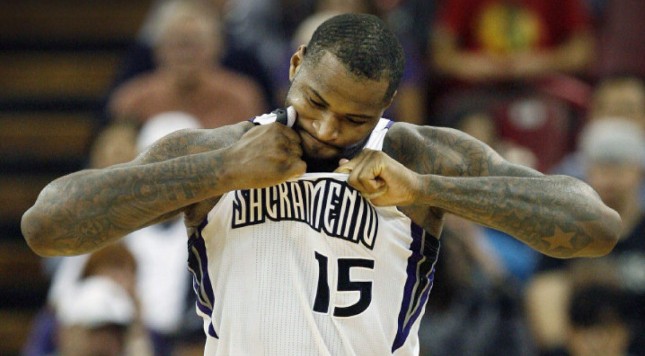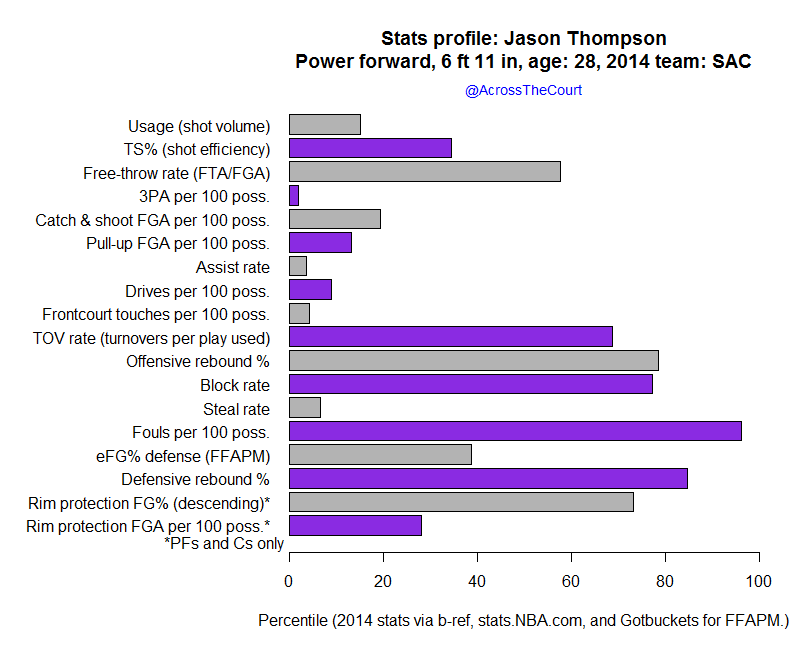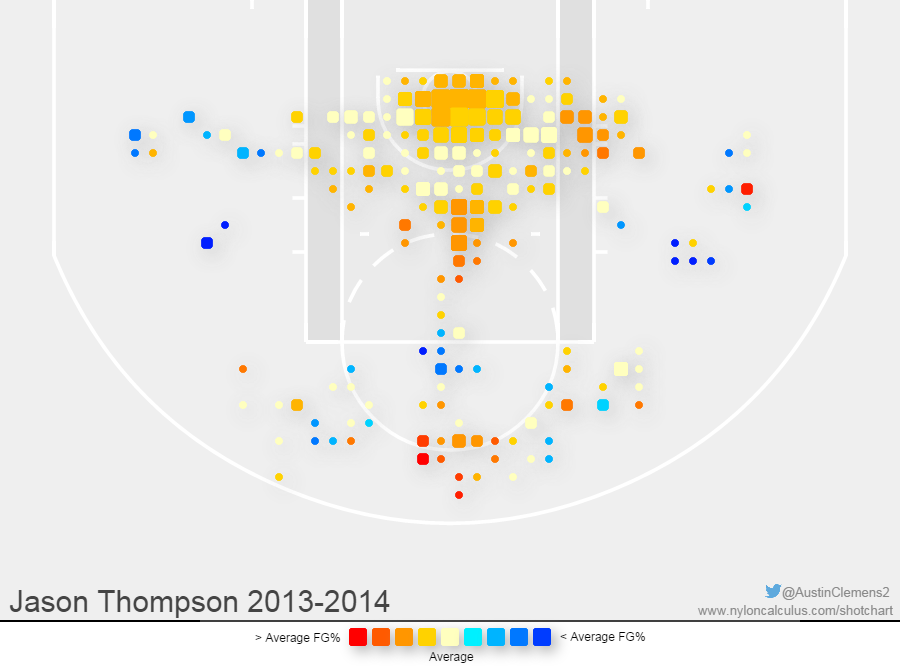Sacramento has made some perplexing decisions the past few seasons, even after the Bluths Maloofs were fired. As the other front offices loaded up with advanced weaponry and statistics that needed entire teams to handle things, the Kings were still defending their moat with a few bows and arrows and t-shirt cannons. But they hired Dean Oliver for a prominent role in the organization. Oliver, for those unfamiliar, is like the Isaac Newton of basketball stats: his ideas led to an entire revolution in how people thought about the NBA, like the basic concept of measuring games in possessions instead of minutes. For whatever mistakes the team has made over the past few years, hopefully the Kings can find some traction because the fans in Sacramento were some of the best in the league and they’ve been threatened with relocation and frustrated by losing seasons for far too long.
2014 in review
For the first time, Cousins had a 20/10 season and he cleared it fairly easily too in only 32 minutes a game. It was the breakout season the team was long for in a player criticized for his maturity and on-court decision making. Cousins accomplished the rare feat of drastically increasing his shot volume and efficiency. Derided for his shot selection, he actually changed nothing and instead became more efficient by hitting his long jumpers more accurately and getting to the free throw line more, as his rate of free throws to field goals increased by 25% (if you don’t believe me about the shot selection, cycle through them yourself.) Unfortunately, his foul issues were not resolved and, once again, Sacramento was outscored whenever he was on the court. The Kings still had issues with defense and orchestrating a modern, coherent offense being among the worst three-point shooting teams and ranking last in total assists.
To complement their high-scoring, rebounding center, Sacramento brought in Rudy Gay, whose talents almost entirely consist of being able to take a lot of field goals and grabbing a fairly good portion of defensive rebounds for a small forward. Thankfully, forced into a smaller role with Boogie on the team, he took less shots and actually rose above the league average for shooting efficiency. Rudy Gay is the poster-child for the relationship between usage and efficiency. Yet given his role in widespread arguments about stats and conventional analysts, it’s a bit strange Dean Oliver has come to the team. Rudy’s the polar opposite from a player he, and his APBRmetrics revolution, would suggest.
Changes
Exit: Isaiah Thomas, Marcus Thornton, Travis Outlaw, Quincy Acy, Greivis Vasquez, Jimmer Fredette, John Salmons, Patrick Patterson, Aaron Gray, Luc Richard Mbah a Moute, Chuck Hayes, Hamady Ndiaye, Jared Cunningham, Orlando Johnson, Royce White.
Enter: Darren Collison, Ramon Sessions, Nik Stauskas, Omri Casspi, Ryan Hollins.
Criticizing what other people do with deals in the NBA as an armchair GM is an unfair practice sometimes and we naturally fail to recognize the difference in perceptions: other people can value other things, and that leads to a lot of decisions we disagree with. But dumping off Isaiah Thomas’ bargain contract of 4 years and 27 million and replacing him with Darren Collison is bizarre and indefensible. Usually there’s some leeway here and you can understand what both sides were thinking. But there’s nothing here. When you hear Sacramento (or some of its fans) explain the decision, there’s usually something in there about Thomas not being a pass-first guard and being too small to play defense. Yet as Kevin Pelton quipped, Collison is a 6′ (barely) point guard who’s had a worse assist rate in two of the past three seasons.
You don’t even have to go to the numbers: when you hear pass-first and defense, you do not think of Darren Collison. Thomas only cost about 1.75 million more a year, which is a small margin when you’re talking about a guy who led your team in minutes, assists, and nearly points. And they had just paid someone on the team nearly the exact same amount as Thomas a year earlier. Who? 30 year-old undersized power forward Carl Landry, who started 1 game out of 18 before getting injured. If you’re looking for more cap space, what’s more important is Rudy Gay’s massive 19 million dollar contract coming off the books after this season, and there are more prudent ways to save under two million than letting a quality young player go — the whole point of having cap space is having the ability to sign those kinds of players. The Kings brought up some bizarre notion that they needed a guard to press-full court to win; but you don’t want to throw out the baby with the bathwater and you have to keep your own strategies in perspective.
When there’s a massive disparity in talent during a trade or an effective swap (a signing then a sign-and-trade), it’s usually because a team wants to rebuild and has to let a quality veteran go. But Thomas is two years younger and he’s just a year older than Cousins. There’s no question of talent either as Thomas scored 20 a game on good efficiency while assisting on a third of his teammates’ shots. Both box score metrics and plus/minus models love him. While he’s Lilliputian in stature, he’s fairly strong, defends much better than people think, and has an amazing array of tricks inside where he shoots 69% within 3 feet. When he played, Sacramento outscored its opponents like a 55-win team. Collison is a career backup point guard … that’s it. To top it off, they brought in another point guard so that they’re now paying more for Collison and Sessions than Thomas, like they’re mocking the basketball gods.
Besides letting go of a fringe all-star, they dumped off a motley collection of guys — Sacramento’s been cycling through players at a high rate. Thornton and Outlaw were the two highest rotation players they won’t have this season. Outlaw never found his place after Portland, and Thornton wouldn’t have found time with Sacramento’s young shooting guards. Jimmer was bought out before the draft and, presumably, before Nik could figure out what happens to the shooting guards Sacramento drafts. Casspi has struggled recently, but he remains useful as a stretch 4. Hollins is just an insurance big man.
Player spotlight
Jason Thompson has been a staple in Sacramento for years, but I assume the average fan knows little about him. The bar plot below is a quick summary and its illustrative of his limitations. He’s a poor offensive player who offers little outside of offensive rebounds and drawing fouls, which is common with guys limited offensively. For some contrast, compare him to Cousins’ enormous role on offense. He had a tiny usage rate, but he’s been closer to league average in other seasons — Cousins and Gay probably had effects. With a minuscule assist rate and few jump shots, he’s of little use.
Sacramento has been trying for a while to find the perfect match for Cousins, but they haven’t been able to top Thompson, which isn’t a compliment. Thompson is a good shotblocker and defensive rebounder, but overall his defense is mediocre and like Cousins he fouls like crazy. Thompson was under the 30th percentile in being within at least five feet of an inside shot (rim protection FGA) and he logs a lot of time at center, but the Kings led the league in fewest shots from the opponent at the rim by percentage. Somehow the Kings were last in field-goal percentage at the rim, but he had the inverse effect: he’s an above average rim protector. Odd numbers aside, overall Thompson grades out average at best on defense for a frontcourt player.
Jason’s jump shot is pedestrian and he has the three prototypical big men jump shot locations: both baselines and top of the key. His jumper has been steady through his seasons and has hovered around the league average in accuracy with low frequency. He scores at average marks in percentages near the rim, which is disappointing given his size. All-star big men clear 70% constantly, but his career average is 65%.
Thompson’s size can be a deterrent as seen in the clips below (link’s also here.) He’s the same size as a big power forward like Aldridge and can swat away shots inside. He doesn’t have the best technical skill in staying with his man or blocking shots, but having the size and quickness to cover both positions is a plus.
Below is a good representation of his offense (link’s also here.) He’ll make a few shots by posting-up with some basic moves like a hook shot, but he’ll rely on crashing the glass too — and he did this versus Dwight Howard. His post-game is probably underrated, as he’s amassed a lot of shots in the post over the years and the results are fairly effective (he’s ranked in the top ten in FG% from 5 to 9 feet here, a range reserved for post-shots for big men and floaters for smaller players.) You can also see him pop out for a baseline jumper. He’s not much of a threat out there and doesn’t draw out defenders, but it’s still a weapon.
Jason Thompson is one of the more anonymous power forwards in the league, but he’s a fairly good match for Cousins. He doesn’t demand shots and he helps by swatting a few shots inside. Perhaps under a better system his length would be utilized properly and his mistakes rectified, but the Kings have tried different power forwards for years and none have been more effective.
2015 projected
Besides losing Isaiah Thomas, the biggest changes I see next season are having Rudy Gay the entire year and their young guys will have more experience. I was surprised to see Sacramento lose nothing in overall strength after Thomas left, but Travis Outlaw was terrible for them and they get to replace his minutes with more useful players. Rudy Gay’s biggest strength might be his ability to be a “minutes eater,” minimizing the damage caused by terrible benches — this would mean Gay is best on lottery teams.
Sacramento gave nearly 2200 minute to a rookie shooting who was flat-out awful, so it’s easy to make up ground and improve. Fans are still insistent on McLemore progressing into an all-star, upset that advanced stats didn’t care for him in college, but I’m hesitant on him even becoming a good rotation player. Nik Stauskas, however, has some promise and it’s an easy bar to clear when your predecessor set shoots 38% from the floor. If Sacramento over-performs, one scenario is that Nik has a top 3 rookie type of season and he displaces a large portion of McLemore’s minutes.
The frontcourt will largely be the same, but given the front office’s opinions on “position-less” basketball it’s difficult to predict how the rotation will shake-out. Thompson is durable and Cousins, obviously, will get a lionshare of the playing time, but how often will they use Rudy Gay as a smallball 4? And how much will Derrick Williams play? Those questions would mainly affect traditional power forward Landry and Reggie Evans. Williams has not justified his draft position, but he’s still young and their backup power forwards are pretty limited. Evans has a handful of skills — rebounding on both ends, setting picks, and playing physical defense inside — but he’s a non-factor everywhere else. He has no range and rarely shoots, like an older Rodman, but he doesn’t have the same defensive acumen. Without his rebounding, he’d be nowhere near the NBA, but that rebounding is phenomenal. Paired with DeMarcus Cousins, they destroy people on the boards: via NBAWOWY, last season when both were on the court their team rebounded 30.4% of the rebounds available on offense and 77.1 on defense. Both values would rank second compared to every team in 2014, and overall that’d be the best rebounding percentage.
As I discussed earlier in the article about letting Isaiah Thomas go, Darren Collison is a far worse player, even on defense. There’s a reason why he’s bounced around from team-to-team. He’s still one of the fastest players in the league, but effectively he’s a tiny shooting guard and on the spectrum of purity for point guards, ranks somewhere near the bottom. Sessions is the opposite, a pass-first guard with a bit of craftiness and quickness. Though for all the love of Collison’s speed and Sessions as a point, both are outclassed by Thomas’ scoring and the team is taking a huge hit there. (Plus the Kings played faster with Thomas last season than the Clippers played with Collison.) If his size is such a liability, how did he shoot 69% within three feet?
But the team belongs to DeMarcus Cousins, for better or worse. His continued development is the driving force of the squad, and there’s a lot of room for improvement. It’s impressive to average over 22 points in 32 minutes, but his foul habits and conditioning need to improve if he wants to make the all-star game in the crowded west. He could miss the all-star game again because wins are important to coaches, but that is partly his fault. His defense is arguably a net negative depending on how you quantify things even with his rebounding. People will cite his obscenely high steal rate, but that’s a weakness: he reaches in constantly, explaining the high foul rates, and it means he’s not contesting the shot. However, his rebounding does have a high value and he takes a fair number of charges. With proper restraint his defense could be an actual plus.
What DeMarcus did on offense last season was rare in the modern NBA. I mentioned this in a piece on usage and how it changes on different offenses, but centers today rarely have high usage rates. Since Shaq it’s basically only been Yao, Amare, and Jermaine O’Neal for a short stretch. Cousins also accomplished something no one else has ever done: clearing 30 in both usage rate and defensive rebounding. (Wilt and Kareem probably did this, but the proper stats were not kept and we only have estimates.) Since usage is hugely important in determining player value and defensive rebounding an extremely important factor for teams, that record should not be dismissed lightly. (Garnett was the closest to joining this one-man club with his MVP 2004 season, but he had a 29.6 usage rate.) He has no one comparable in NBA history. He’s like an evolutionary hybrid of Chris Webber and Zach Randolph. Though I will caution his long two-point accuracy was beyond his historic averages, and he could likely regress and fall back on efficiency. What remains to be seen is if he can help recreate the magic of Webber’s stretch in Sacramento and help make the playoffs for the first time in a while — but it won’t be this year.
Summary
Hopefully the franchise is beyond making head-scratching decisions because they’ve been a poor team for a long time. One rumor during the summer was their interest in bringing in Josh Smith — they just have a fundamentally view of basketball than I do. They’re stuck in mediocrity right now, and there’s no chance of a Phoenix Suns-ian resurgence because we’ve seen what most of their players can do with long track records. Rudy Gay isn’t going to change and he’ll remain a lukewarm scoring option who doesn’t offer much else, and their new point guards have no potential left. The roster’s a bit of a mess, but they’ll be clearing cap space soon and they have the guy who started the NBA analytics movement, Dean Oliver. A cynic might say this is a crowd-pleasing move and one meant to prop up the reputation of the front office, but by the accounts I’ve seen he will have a large role. Sacramento has had a tendency to after guys who don’t rate well in advanced stats, so if that trend stops we may know Dean’s influence. Meanwhile, the Kings will be the DeMarcus Cousins show. I suppose there are less entertaining ways to lose.
Wins: 30
Losses: 52
Conference rank: 13th
League offense rank: 21st
League defense rank: 27th
Edited 10/27/2014






















